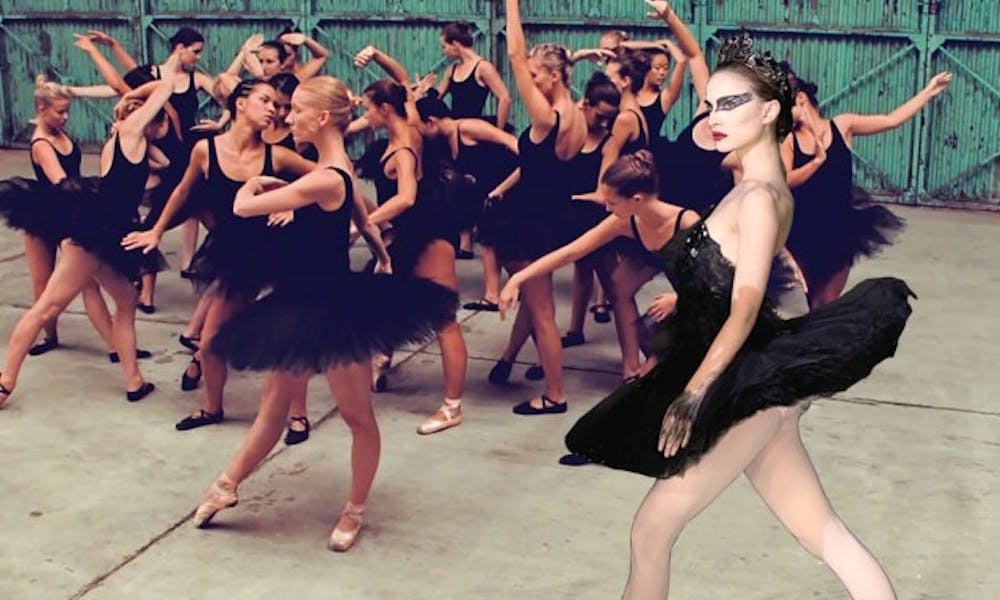In Darren Aronofsky’s well-dressed horror film Black Swan, one scene in particular is a crucial demonstration of how the film could’ve succeeded, but ultimately chose not to.
Natalie Portman’s pathological ballerina, Nina Sayers, has recently been chosen as her company’s Swan Queen for an upcoming performance of Swan Lake. Frustrated by her wooden Black Swan, the company’s leader, Thomas Leroy (Vincent Cassel), encourages her to embrace her sexual side. And so, here we are, in bed with Nina as she begins to masturbate one bright and hopeful morning. After at least a minute of watching her body twist and undulate from a practically skintight distance—an experience both sensuous and discomfiting—the camera twists abrasively around to the wall of the room, where Nina’s obsessive mother lies slumped in a chair, asleep.
This revelation is completely, utterly chilling, and it’s the type of psychological terrorism that Black Swan abandons for the shock tactics of its campy and monotonous second half. And ultimately, the film stumbles over and over as the plot’s sense of reality begins to fray. It’s scary, sure, and comes to a conclusive, distinct end, but for a film about a supposedly sympathetic and troubled human being, the narrative is thin as paper—Nina becomes a sexual curiosity and fetish object, nothing more.
Not everything about the film fails, though. What works is the direction. Aronofsky orchestrates Black Swan using an extreme closeness of camera, hugging Portman’s face and the back of her head so that often, she is the only thing the viewer has to look at. Under most circumstances, this would be a good thing, and at points, it is: Portman mesmerizes, and her performance spans impotent, demure deference and scenery-chewing displays of anger.
But this coup of cinematography is completely undone by the narrative. Black Swan is a love story between its director and its subject. Nina is an idol, a blackened totem, a porcelain doll, and we want her to exist, Aronofsky wants her to exist, but everyone knows that she cannot.
The problem is, her disintegration, in the film’s currency of hallucinations and sexual mania, does not even begin to convince. Instead, and with frustrating and dogged determination, the plot becomes increasingly arbitrary, as though Aronofsky were just trying to go from point to unrelated point on a path the screenwriters had lazily plotted out. The most basic Hollywood slasher flick—Halloween, Scream, Cabin Fever, choose your favorite—does a better job of conveying emotion than Black Swan.
Nowhere is this failure better encapsulated than in the character of Lily, Nina’s sexual and professional rival. Lily is a captivating character, played with spunk and charisma by Mila Kunis, and were she to be treated with any sincerity, she would have remained a love interest and threat to Nina in the more than scary-enough confines of reality. Instead: lesbian sex! backroom stabbings! and it’s all imaginary! Or some of it, anyway! In the end, the total insignificance of Lily as any more than a cheap prop for Nina’s untethered psychosis is truly infuriating, a missed opportunity to create a slim but desperately needed human element.
Two of the year’s best examples of how to properly isolate and study an actress and her character aren’t even feature films, but they help demonstrate how and why Aronofsky fails. Both are weird, both are unique and both give hints as to what Black Swan should have actually been.
The first is an advertisement. In their ambitious and sort of lunatic campaign to hock the Lady Dior handbag, Dior conscripted some big-fish directors to create short films with the bag at the center. The great and twisted American auteur David Lynch, who, having worked successfully in artful horror, presents a notable precedent to Aronofsky, offered a 16-minute blast of weirdness called Lady Blue Shanghai.
As per the restrictions of Dior’s campaign, the piece takes place in Shanghai and features the Pearl Tower and handbag prominently. Where Lady Blue serves to illuminate Black Swan is in its deification of the star. Marion Cotillard serves as a spiritual sibling to Portman’s Nina, a beautiful girl in diabolical circumstances, unmoored and worshipped by her director’s camera. The difference is that, in direct contrast to Aronofsky, Lynch only seems to care about the reasons behind his star’s distress. Disorienting flashback and rampant symbolism—a blue rose, flashing lights, mysterious music—serve to tell us more about the motivations and life of Cotillard’s character than we can ever figure out about Nina, and in a tiny fraction of the time. Lynch evokes and suggests while Aronofsky demands and ignores.
The second is a music video. Soundtracked by most of the songs on his spectacular My Beautiful Dark Twisted Fantasy, Kanye West directed a bizarre and gorgeous 34-minute film called Runaway, which tells the story of a birdlike human creature (Selita Ebanks) that has fallen to earth. Done with delicacy and taste, the only difference between West’s treatment of his obsession and the techniques of Lynch and Aronofsky is that he inserts himself directly into the narrative. But with the same need to grasp the female psyche, West uses colors, decadence and his music to try and show passion.
Ironically, Runaway also uses ballet to great effect, but unlike Black Swan, the form serves to accentuate emotion rather than contain it. Though the dialogue is clumsily written and the story of fairy-tale simplicity (sometimes a virtue and sometimes a vice), Runaway succeeds where Black Swan fails because it confronts its creator’s obsessions with a strong and consistent aesthetic, instead of trying to stuff them inside the framework of a Hollywood film.
If Aronofsky had focused on his strengths—a knack for presentation, a riveting star and a beautiful, already complex-enough subject in ballet—he could’ve made an experimental film that would’ve likely been a powerful, possibly transcendent piece of art. Instead, Black Swan is a cheap and shallow horror flick, sopping with unrealized potential. o
Get The Chronicle straight to your inbox
Signup for our weekly newsletter. Cancel at any time.

